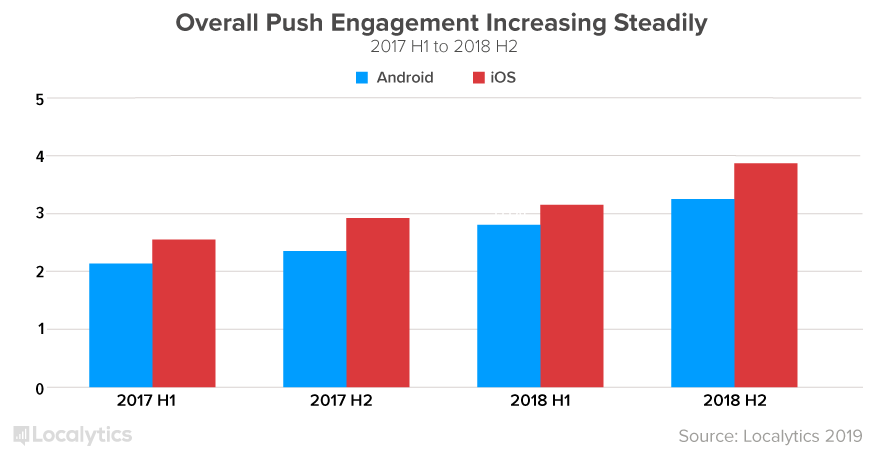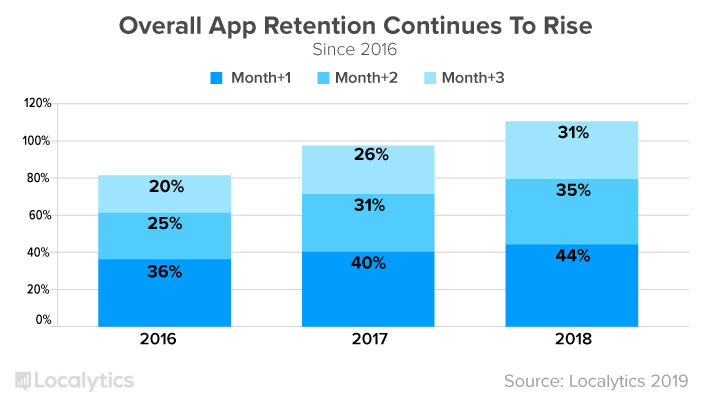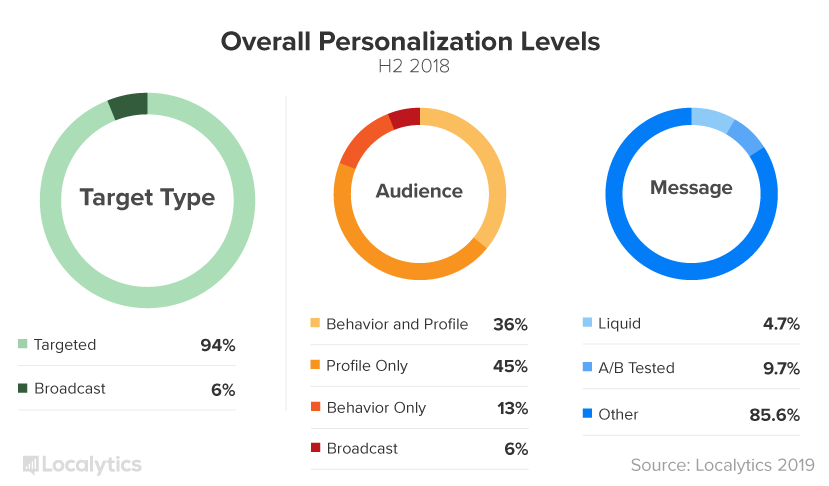Since push notifications entered the scene their use has grown at an exponential pace, but the story has not always been so bright. In 2016, we discovered that mobile engagement was in a crisis. Since then, we’ve seen signs of improvement in the form of greatly increased retention, but the current state of push notifications has not quite reached its full potential yet.
Despite the mobile engagement crisis, our biannual benchmarks remain the best way to compare how your app is performing relative to the competition. This time around, we found both good and bad news. Let’s start with the good news. For reference, check out our newest benchmark report, which combines all four industry verticals (Travel, Media, Business, and Retail) into one overall report.
Push Engagement and App Retention On the Upswing
The increase in use of targeting in mobile campaigns has yielded positive returns when it comes to actual messaging performance: push notification engagement rates are on an upswing. Engagement is calculated as the number of sessions the average user completes within seven days of push receipt.

Push engagement saw increases of 38% on Android and 32% on iOS YoY from 2017 H2 to 2018 H2. This change is coupled with 15% and 22% increases respectively from the first half of 2018 to the second, indicating a strong trend upwards.
What’s more, retention has proven to be stalwart as well, pointing to a substantial change in how marketers think about reaching their end-users. These days, users are retained at a much higher rate than they were just a year ago.

The final numbers for 2018 bring the overall retention rates for 1-month, 2-month, and 3-month periods up 44%, 35%, and 31%. Compare this to last year, when they averaged 40%, 31%, and 26%. That’s a 10% increase in retention of users who launch an app after one month, a 13% in 2-month retention, and a whole 20% increase in 3-month retention.
Retention has an undeniably positive effect on your business results. In fact, increasing customer retention rates by 5% increases profits by 25% to 95% and acquiring a new customer can be five to 25 times more expensive than retaining an existing one according to HBS. Increasing retention is merely a function of offering value to users by sending targeted pushes with dynamic content, guiding them through the app experience with on boarding and in-app notifications, and A/B testing your messages. It all comes down to how personal the experience is and how much users feel that you care.
The Downside: Time In App Is Trending Down
2018 was the year that marketers took the concept of retention and completely defied our expectations. However, it was also the year that we learned how difficult it is to follow the winning formula: maintaining a strong user base and incentivizing more time in apps. The second half of 2018’s benchmark report brought this concept even closer to the forefront and indicated that there are still some areas where marketers could improve their strategy.
For instance, monthly app launches increased noticeably in 2017, but decreased in 2018. This reflected in time in app as well, which decreased 14% in the last year. Session lengths, on the other hand, did not see as much change, only dropping 4% year over year.
| 2017 H1 | 2017 H2 | 2018 H1 | 2018 H2 | |
|---|---|---|---|---|
| App Launches – Monthly | 15.89 | 14.34 | 13.70 | 13.20 |
| Session Length – Monthly (minutes) | 04:38 | 04:38 | 04:33 | 04:20 |
| Time in App – Monthly (minutes) | 73:34 | 66:23 | 62:20 | 57:09 |
This decrease in total usage metrics likely reflects how apps have shifted in terms of their utility to the end-user. Initially, consumers enjoyed spending exorbitant amounts of time using apps; today they’ve become tools for exploring their interests and getting things done. That being said, it’s not impossible to draw users back in and offer them valuable content on a regular basis.
Activating Users the Right Way
There are a few tried and true methods for reaching out to your app users that show how well you know them (without coming off as too invasive). At the top of this list is personalizing notifications so that your message draws people in. We find that marketers as a whole might achieve even better results with a more personalized approach. Targeting with user profiles (i.e., name, birthday, location) and behaviors (last item viewed, did or did not checkout) or A/B testing and inserting dynamic/liquid content into messages are some of the best ways to accomplish this. Check out how marketers are performing overall in this area.

The great news is that use of targeting is high, coming in at 94% of campaigns, with only 6% sending out less effective broadcast notifications. On the other hand, while targeting audiences using profiles is quite effective, a combination of behavioral and profile targeting yields the best results. In addition, marketers may be missing out on the magic of dynamic content, as only 5% of mobile marketing campaigns feature it despite the potential gains, and A/B tested campaigns come in at around 10%, which gives us something to work towards.
All in all, we extend congratulations to 2018’s app marketers for having reached stage 2 out of 4, which is an intermediate personalization level. Be sure to celebrate, but not too hard!

